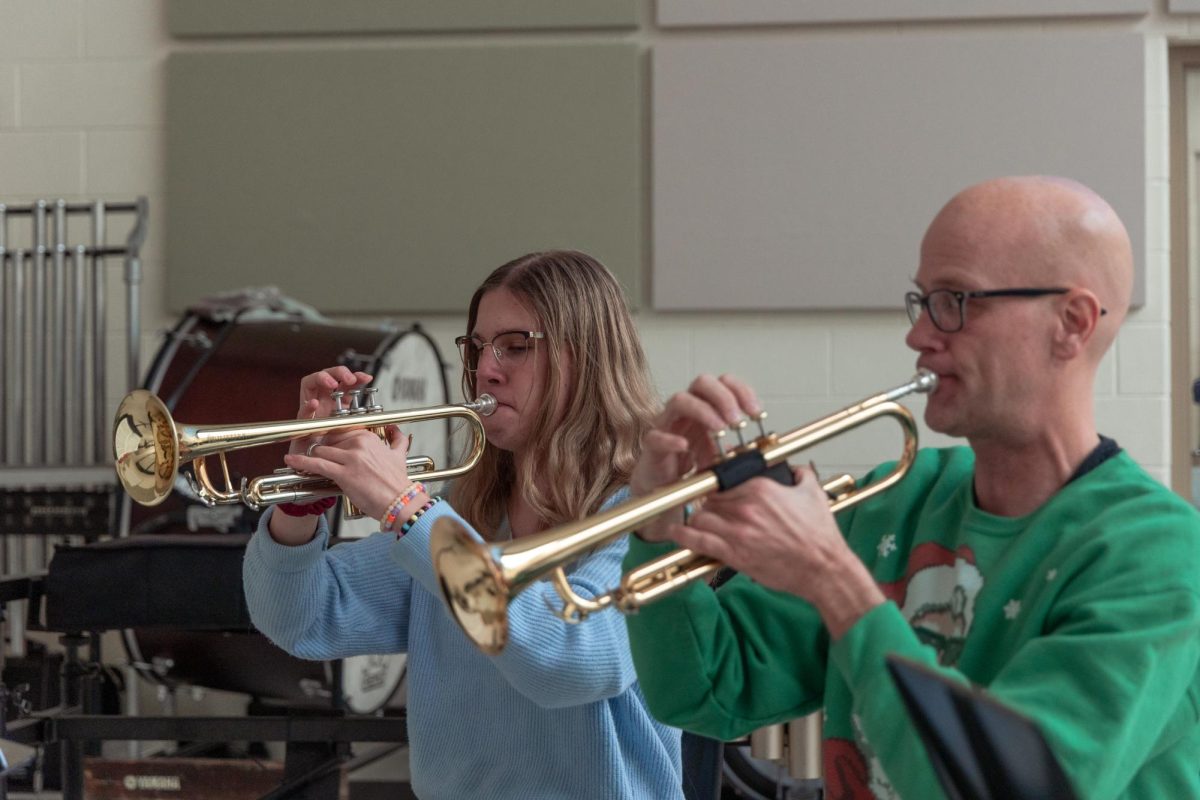A year ago, when District 203 educators first proposed a series of changes to its high school music programs, technique courses were an abstract idea.
Designed to meet once to twice a week for 25 minutes of a student’s lunch period, technique courses would allow students to receive targeted feedback in a way that was previously difficult, Naperville North’s Fine Arts department chair Nicholas Janssen told the Central Times in January.
Only students participating in a musical extracurricular without being in a curricular music class would be required to take the course.
Then on Jan. 23, the district passed the proposed changes to the music program by a 4-3 vote, and suddenly the courses were a lot more than an idea. They were something that needed to be planned and developed. Something that needed to be put in front of students, come the new school year.
So that begs the question: What do these courses really look like? Who is taking them? Have they benefited students? If so, how?
—–
The structure of a technique course can vary wildly between disciplines, times of the year and even class period.
“As it’s new, everyone is figuring out what works best for their discipline,” band director Brandon Estes said. “Our needs for band, choir and orchestra are quite different. So there is some differentiation that’s going to happen within our disciplines.”
In band technique courses, students spend most of their time working independently, before checking their progress with an instructor.
“I am only scheduled to meet with a student one day a week and I’ve got different instruments organized on different days,” Estes said. “They come in, and I will listen to them. Usually each student, if they come in ready to go, they play this one, they play this one, they play this one, I give them short feedback. It’s either a pass or I need to hear this again next week. Nothing is for a grade. It’s simply feedback for that individual to let them know where they are with that individual exercise. We’re working on fundamental things. So we’re not working on our concert music.”
The actual exercises students perform vary by grade level and proficiency, with freshmen working on more rudimentary techniques while upperclassmen take on more advanced skills.
Not everyone is happy with that arrangement, though.
“I don’t really have a choice,” sophomore Brody Kim said. “I kind of just have to do technique. It was stuff that I kind of already knew. I just had to like play some songs. They weren’t that hard.”
Kim, like most students enrolled in band technique, is required to do so because he is involved in a musical extracurricular, but is not enrolled in a curricular ensemble.
But the number of students required to take these courses can vary widely across Central’s musical programs. For orchestra and choir, the number is in the low single digits, while the number in the band program is much higher.
“Currently in our program, we only have three students that are required to take technique that are involved in or extracurriculars that are not in performance based class,” Central choir director Kelly Mielcarz said. “But with that being said, In our current unit we have 50-ish students.”
Almost all of those students attend voluntarily. In the course, they receive instruction on various elements important to signing.
“What we’ve done here in choir is different from how band and orchestra are rolling it out,” Mielcarz said. “So what we have done in the choir world is we developed five different units. Our first unit was ‘aural skills,’ with a lot of ear training- scales, triads, intervals.”
This structure may be a part of why so many students are drawn to the course, according to one student.
“I felt like I have trouble with sight reading, I’m not awful with it, but I could always use more practice,” said senior Meera Dullur, a curricular choir student. “Out of all of the technique stuff, sight reading was the one I felt I could get the most out of.”
Across all units, 75 of the 98 students enrolled in curricular choir have attended a technique course, according to choir director Lauren Berryhill.
Central’s orchestra has a similarly low number of students required to take technique, so they chose to gear technique classes towards a different type of student.
“We approach it as more of a holistic sort of approach, offering [technique] to students that need extra support,” orchestra director Jesse Gross said. “A lot of our students have access to private lessons and private tutoring. It’s a privilege, right? That’s not the case for a lot of students in every school across the country. So through technique, in orchestra, we’re not so much trying to get kids that are in the extracurricular ensemble the support they need, but with all of our kiddos that need support that wouldn’t have access to it otherwise, [we’re trying to give them] time to get support with their technique.”
Technique has been beneficial for all students, it is here to stay for the near future.
“I think it’s great,” Estes said. “I think with some refinement, and a more positive outlook on what we’re trying to do with and for our students, I think it can be very, very successful. This year has just been working through those hurdles. And over time, I think that we’re going to see a much more positive and a much more successful program from it.”
Gross is able to give more individualized support in technique settings, because of the smaller group sizes.
According to Gross, about 38% of curricular orchestra students have chosen to enroll in technique, although according to one student, it didn’t exactly feel like a choice.
“[The directors] said at the beginning of it where you had to go otherwise they would mark you tardy or absent,” said junior Chanelle Phillips, who is currently in intermediate orchestra. “Unless you’re in [advanced orchestra] or already doing private lessons, then you can not do technique.”
In band, senior Kaitlyn Michalski chose to enroll in technique despite already being in a curricular ensemble because they were unable to access private lessons.
“Even though I’m in a curricular ensemble, we don’t get a lot of one-on-one time,” Michalski said. “So if there’s a new technique, we might get like 10 minutes during a band period to step aside with whichever director is not conducting to work on whatever this new technique, we need it for the pieces but then we’re on our own. So this really helps to solidify those techniques.”
Gross and Mielcarz also reported an improvement in ensemble performance due to technique.
“It’s just been really really good,” Gross said. “It’s been new to navigate, and there’s a lot of stuff that we need to talk about. But I’ll tell you, I take it any day of the week because people are learning and they’re playing scales and we’re talking about technique and they’re getting to know each other and it’s been really cool. And I take that any day of the week because it’s time spent learning, time spent thinking about music and talking about music. It pays off. However you want to quantify it, I’ve seen positive growth.”
There are non-musical skills developed in technique as well, according to Berryhill.
“It’s also nice to watch students develop their own advocacy skills while asking for help developing their own independent skills,” Berryhill said. “[Students are] identifying their own problems without a teacher. Then when the teacher comes, watching the students be able to articulate like ‘I’m having a hard time going from ‘mi’ to ‘fa.’ I’m having a hard time holding half notes for two beats. It’s been cool developing those SEL skills too.”
Still, some students, like Kim and Phillips, don’t believe the course has had any impact on them.
“I already know how to do all the stuff they tell us to do,” Phillips said. “It helps with people who need to know how to do the technique itself, such as vibrato. But because I had a private teacher [in the past], and I’m in intermediate orchestra, it’s really easy for me to do it and I feel like there should have been an option like ‘I already know how to do this. I shouldn’t be here.’”
Though satisfied so far, Estes believes the benefits remain to be seen.
“The ensembles are doing well, but I don’t know that we’re at the point to say that, because we had students come in for technique at the beginning of the school year, the marching band or the curricular ensembles or the jazz bands are even better than they were last year,” Estes said. “I think the biggest wall that we’re having, at least with us here at Central, is the consistency of the students coming. A lot of times students forget, right? Or students are sick, or teachers have meetings, sick days, those sorts of things. And so there may be more inconsistencies [in] meeting with those students. So you know, that’s, that’s definitely been a challenge that I get to be gone. It’s the consistency of seeing students. But anytime you start something new, there’s gonna be some celebrations but there’s also going to be some areas for improvement.”
Regardless of whether or not the the technique has been beneficial for all students, it is here to stay for the near future.
“I think it’s great,” Estes said. “I think with some refinement, and a more positive outlook on what we’re trying to do with and for our students, I think it can be very, very successful. This year has just been working through those hurdles. And over time, I think that we’re going to see a much more positive and a much more successful program from it.”





